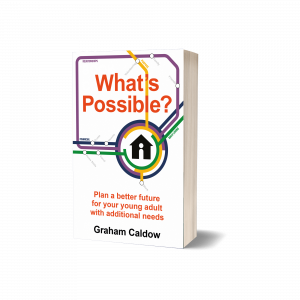
At some point you might wake up, as I did, and realize the years have passed and you’re spinning along without a plan for your young person. I got to this point when my daughter approached 16. We’ve all heard of the “cliff-edge” metaphor, and at that moment in time I realized it was true.
Time had run away, and I knew I needed to start her future plan then and there, even if she might not be ready to participate in the conversation.
But our story had two parts before I got to this realization. The third part to our story led us to a life plan.
The First Start to Our Story
I thought I knew what being a dad was all about because I had a lively two-year-old daughter. But that changed in an instant when my second daughter was born. I suddenly found myself in a world of health professionals who couldn’t answer my questions about what would happen when she got older. Instead, they told me what not to expect and what she wouldn’t be able to do.
Maybe I didn’t want to hear this. Maybe I naïvely thought everything would turn out all right in the end. But I also saw the gap between her and her peers widening at school, even though she received 1:1 support.
That’s when we (my wife Debra and I) took our first action – to make sure she went to a specialist speech and language high school. I believed speech and language along with occupational therapy support would move her forward. And it did.
The Second Start to Our Story
I became very relaxed with the routine at this school. Visits to the hospital were less frequent and my daughter was in a place where she felt comfortable with her peers. As she often said, there are no bullies at this school.
With all the support provided she was making steady progress, but not necessarily as much as we’d expected. At home, she didn’t do as much around the house as her sister had at the same age. She had no deep friendships; if I’m honest, no friendships really. She liked her classmates, but those relationships never moved past the school gates.
When I thought about what she might do when she finished full-time education, I couldn’t realistically see what job she might find after college. She didn’t appear to have the concentration levels or people skills that would facilitate paid work. Worse, the education system didn’t appear focused around her moving toward employment.
I could definitely see that cliff-edge: in fact we were sitting on it with our legs dangling over.
As she approached the move out of education, we needed to think more about her future. School had been a respite, an enjoyable one for her, but the rest of her future loomed without a feeling there was a direction.
The Third Start to Our Story
I realized we needed a plan, a life plan that would see her over these transition years to work and to become more independent of us. But all the life plan templates I found online categorized life into areas that just weren’t relevant to her now, and possibly never would be.
Four categories always seemed to feature:
- Lifestyle and Home were covered in an aspirational way, like finding the perfect house and making the perfect home. All my daughter needed to be able to do was live away from us one day and not rely too heavily on other people, so she retained her dignity.
- Relationships were framed in making more connections and greater intimacy with a partner. What my daughter needed was some friendships to begin with and to not be so lonely.
- Career focused on progression and how to get that next job or that next promotion. All my daughter wanted after education was a job or a voluntary role where she was valued.
- Wealth and Finances were about becoming richer and affording those dream purchases, from designer labels to high-performance cars. What my daughter needed was enough money to live her life exactly how she wanted to.
My daughter’s life plan needed categories like these but reimagined around her life to allow her to progress to living more independently. Looking at what would take her there we decided there were four areas that her life plan needed:
- Daily Living skills so she would be able to do more for herself, manage her own life, understand how to be safe, and travel to where she needed to go.
- Relationship management strategies so she could interact with people, both at a close level with family and friends, and at a more distant level with acquaintances she saw occasionally.
- Purpose to her day after education so she wasn’t stuck at home unfulfilled where, over time, her ability to engage with the world would diminish.
- Financial organization, not necessarily to control all her finances but rather to know how she should use and spend money in her day-to-day life.
Developing and implementing her life plan with her has taken time, but I’m convinced it is the reason she does more around the house, has friends she meets regularly, has a part-time paid job, and is able to track what she spends.
Of course, it hasn’t been easy for her or us. There have been mistakes as well as things that have worked better than we expected. All these learnings have inspired me to write a book about creating a life plan called, “What’s Possible? Plan a better life for your young adult with additional needs.”
Conclusion
When I look back, I realize the important thing is to start. I wish I helped her do this earlier, but I’m forever grateful that, despite our slow start, she is in place where she is happy and sees her future life clearly. A conventional life plan simply doesn’t work for our young people, yet we need to make a robust life plan, often for them initially but over time with them, so they have a plan for their future. I believe trusting to luck takes away chances and robs our children of opportunities to head in the direction best for them. A life plan gives them the greatest possibility of living the life they want. And speaking for our family, the peace of mind we now have about how she will live her life is a wonderful added bonus.
Graham Caldow

____________________________________________________________________
With my daughter we’ve created a cooking program called Independent Cooking Made Easy. It’s a Safe, Simple, System that shows you how to teach someone with additional needs how to cook for themselves without your supervision or support.


I’m the father of a daughter with additional needs. I understand how the journey can be tough, frustrating, and lonely. Sometimes it’s hard to imagine a future where they are secure, have self-dignity, have purpose in their lives, and have a community around them. I learned a lot from our journey, and that’s why I wrote, What’s Possible? Plan a better future for your young adult with additional needs. It shows you how to start making a life plan with your child.
